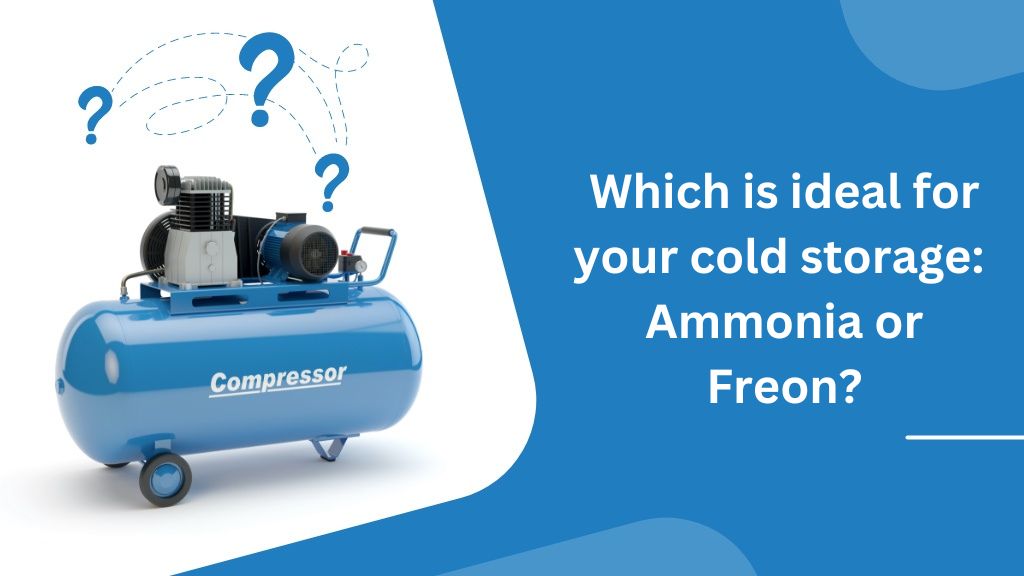You are not alone if you are debating whether to use Ammonia or Freon in your refrigeration system. Many facility operators are faced with this issue and are unsure what to do.
While both have advantages and disadvantages, this article will compare Ammonia and Freon Gas technology, as well as the benefits of Freon Gas Technology, so you can make a better informed selection for your facility. This will also further help you to decide on which ammonia compressor or freon compressor will be best for your refrigeration system.
Ammonia was the coolant of choice in older refrigeration systems. It was inexpensive and simple to use, and the technology was simple.
There are several alternative cooling agents on the market today. Changing to new technologies can be a challenging decision. Technology is becoming more sophisticated, and energy efficiency of 20% or more are fairly unusual.
Sadly, this frequently necessitates the replacement of obsolete equipment. Yet, by carefully analysing all of the choices, making the move may pay out in the long term.
The Fundamentals of Ammonia and Freon Gas
Ammonia Gas
In big commercial units, ammonia is a frequent refrigerant. Because it is inexpensive and simple to install, it is frequently utilized in heavy duty industrial compressors like Grasso, Sabroe and Mycom compressors. Despite its efficacy, it can be dangerous and combustible. Ammonia (NH3 to science nerds like us) is a naturally occurring refrigerant.
That is why it is critical to use it carefully and just as intended. The good news is that Freon and other safer alternatives are quickly replacing it.
The use of Freon Gas
In the 1930s, Freon gas, sometimes known as Halocarbon, was produced as a refrigerant. It is a colorless, odorless, noncombustible, noncorrosive, and low toxicity gas.
Freons are particularly essential refrigerants due to their low surface tension, viscosity, and boiling temperatures. These are exceptionally stable and inert substances.
Halocarbons are classified into two types: those based on ethane and those based on methane.
- Because of concerns about ozone depletion, methanes are no longer employed in industrial settings. (As part of the Montreal Protocol in 1995, the frequently used halomethane R-12 was phased out. Similarly, R-22 manufacture will come to an end soon).
- Ethane-based halocarbon systems are often used in modern processing facilities.
Ammonia VS Freon Gas Technology
Cost:
Freon: A halocarbon system is almost mostly required if the load of a refrigeration system is less than 100 tonnes (1.2 million Btu/h). Infact, halocarbon (Freon) may be used in much larger systems, and many people do so for a number of reasons.
Most halocarbons have smaller, less costly compressors and require less compression energy at low food freezing temperatures (-30F to -45F).
Furthermore, for certain purposes, establishing a Freon system is often less expensive than building an Ammonia system, which has a substantial influence on project expenditures.
Ammonia is the least priced refrigerant. R22 is around 2.5 times more expensive per kg than ammonia, whereas R134a is roughly 7.0 times more expensive.
The operation expenses for large cold storage facilities are 20-30% lower with Ammonia compared with R22. Also, because ammonia has a lower density than halocarbons, a system may be charged with half the amount of material.
Product and temperature specifications:
Freon: Medical freezers and environmental chambers that store temperature-sensitive samples, specimens, and drugs are safeguarded by dependable and effective very low-temperature (VLT) refrigeration systems.
This refrigerant is used in environmental chambers and medical freezers that require very low temperatures (VLT) of -40 to -73 °C (-40 to -150 °F).
Ammonia: For a long time, ammonia has been used in locations such as slaughterhouses, dairies, breweries, petrochemical plants, and anything that requires a lot of cooling.
Although ammonia is a viable option for bakeries that use spiral freezers, bakeries typically do not have such significant cooling requirements.
Using ammonia instead of freon for a blast freezer with a temperature below -20°F was formerly thought to make more sense. Nevertheless, with the advancement of Freon Gas system technology, this attitude has shifted, and it is now ideally suited for blast freezer applications.
Effectiveness:
Freon: Yet, a well-designed halocarbon refrigeration system may compete with and perhaps outperform Ammonia systems in terms of productivity by up to 25%.
This is why having a system tailored to your specific requirements by an experienced team like JEC is critical.
Ammonia: It takes less pounds of refrigerant to do the same amount of work.
An Ammonia system will be less expensive to operate since it takes less horsepower to move the refrigerant mass.
Usage:
Freon: This refrigerated gas technology is essential in supermarket display cases, food storage and processing, ice machines, the pharmaceutical sector, and other applications.
Ammonia is a nitrogen supply, a stabilizer, and a neutralizer. Ammonia is also used in waste and wastewater treatment, cold storage, rubber, pulp, and paper manufacturing, and the food and beverage industries. It is also used in the manufacture of pharmaceuticals.
Care and upkeep:
Freon is simple to maintain since well-trained heating and air conditioning contractors can handle it themselves.
Ammonia: If you want to keep your Ammonia system in top shape, you need to know what you’re doing. If you are not a qualified technician and are unfamiliar with the system, you should hire one to handle it for you. You could keep things going on your own with a tiny system. But, if it is a huge system, you should look for a provider that has a network of qualified specialists on call in case of a problem. If you live more than an hour and a half from a service facility, you might not want to go with an Ammonia-based system.
Pros of Freon Gas Technology:
The majority of Freon systems utilize hermetic or semi-hermetic compressors and air-cooled/water-cooled condensing, however others use open-drive compressors and evaporative condensers.
The open-drive system motor rejects the majority of the motor heat to the atmosphere, whereas the hermetic or semi-hermetic compressor rejects the majority of the motor heat to the refrigeration system. Instead, heat from the motor might be transmitted to the water cooling system.
Conclusion:
Ammonia and Freon gas technology is ideal depending on the type of industry. Mostly ammonia is used in cold rooms , ice plants , used for cooling different gases , fisheries , blast freezer, iQF etc. Freon is for comfort Air-condition and small ice-cream plants , departmental stores Freezer etc. You can speak to our experts at JEC if ammonia compressor or freon compressor is ideal for your refrigeration system depending on your specific industry needs and requirements.
JEC is a leading supplier for Ammonia compressors and Freon compressors for a wide range of industries. Contact JEC at the following phone numbers if you are interested in buying commercial and industrial refrigeration compressors or their parts: +91 22 67586605 / 06 / 07 + 919821020357. You may also email [email protected] or [email protected] with any queries. Or you may fill out this form to send a message, and JEC’s expert will get in touch with you within 24 hours.


